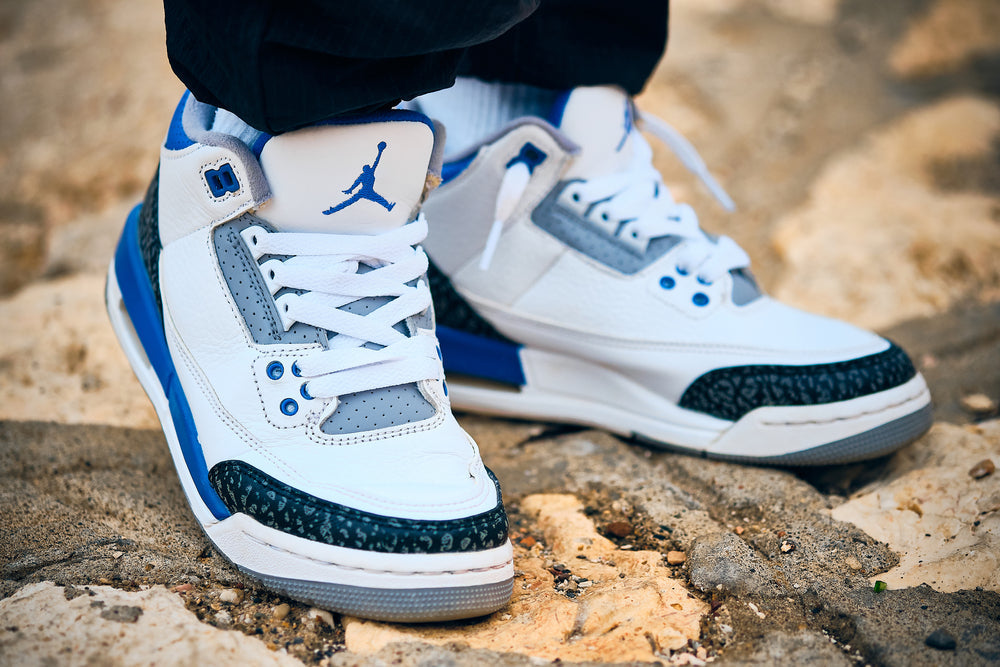
Lacing your Jordan 1 sneakers is not just about keeping them secure– it's also about achieving the right balance of comfort, style, and fit. If you’ve ever wondered how to lace Jordan 1 sneakers for the best results, you’re in the right place. Whether you’re looking for a snug fit for running errands or a relaxed look to complement your outfit, how you lace your Jordans can make a big difference.
Jordan 1s are iconic for their design, but they also offer versatility in how you wear them. From high-tops to low-tops, lacing techniques can adjust the overall feel and appearance of the sneaker. We’ll explain how to lace them up to maximize comfort and style without sacrificing functionality. Plus, you’ll learn easy-to-follow tricks for different occasions, ensuring your Jordan 1s always look their best.
Understanding the Importance of Lacing Your Jordan 1s Properly
Lacing your sneakers correctly is more than just a fashion statement. The way you lace your shoes can impact how they fit and how comfortable they are throughout the day. Poor lacing can lead to discomfort, foot pain, or sneakers that feel too tight or loose. It’s essential with Jordan 1s, as they come in different cuts, and each may require a different approach to getting the right fit.
Proper lacing can also help extend the life of your sneakers. By evenly distributing pressure across the eyelets, you reduce wear on the material and keep your shoes looking fresh for longer. When done right, lacing can even give you a customized feel. Whether you want to tighten things up or create a looser fit for a more relaxed look, getting the lacing technique right can make a world of difference.
Additionally, properly lacing your Jordans can improve overall foot health. If the laces are too tight, they can cause painful pressure on your feet, while loose laces may cause you to trip or feel unstable. The goal is to find a middle ground where the shoes fit securely but not too snug. This ensures you get the maximum comfort and support, allowing you to wear your Jordan 1s for longer periods without feeling discomfort.
How to Lace Jordan 1 Sneakers for Comfort
When lacing up your Jordan 1s, the first priority should always be comfort. A pair of sneakers might look great, but if they don’t fit well or cause discomfort, they’re not worth wearing. To achieve maximum comfort, you’ll need to experiment with different lacing techniques and adjust them according to your foot’s shape and the activity you’re doing.
Start by threading the laces through the bottom eyelets for a basic yet effective fit. Pull both sides tight, but not too tight—comfort is key here. Ensure the laces are centered so they don’t rub against your feet. From there, you can either cross the laces over each other for a standard crisscross pattern or try bar lacing for a cleaner, more uniform look.
One of the most common problems with Jordan 1s is the tongue sliding around, which can create discomfort. To prevent this, you can lace the shoes to keep the tongue in place. Try pulling the lace tight in the middle of the shoe, then tie it securely to keep the tongue from shifting. This method can help prevent irritation and ensure the shoe fits snugly.
A key factor to keep in mind when lacing for comfort is the way the laces sit against the eyelets. If your laces feel like they’re digging into your feet, it could be a sign they are too tight in specific areas. You can fix this by adjusting the tension across the shoe, making sure to distribute the pressure evenly. If you're on the go and need a quick solution, consider the "lace lock" method. This adds another layer of security, preventing any unwanted slippage while keeping the fit comfortable.
How to Stylishly Lace Jordan 1s
When you’re after a look that turns heads, lacing your Jordan 1s to match your style is just as important as choosing the right outfit. While comfort is still a priority, the way you lace your Jordans can take your sneaker game to the next level. Depending on the occasion, you can try different lacing styles to fit your vibe.
For a classic look, you can go with the traditional crisscross pattern. It’s simple, clean, and timeless. If you’re looking for something more unique, bar lacing is another excellent option. This style allows the laces to run horizontally across the shoe, giving it a sleek, modern appearance.
Another popular style is the loop-back lacing, which creates a distinct pattern and works well with high-top Jordan 1s. This style helps keep the laces neat and tight while allowing for a bit of flair. You can also opt for a loose-lace method to give your Jordans a more relaxed, effortless look. Be careful not to loosen them too much, as this can affect the overall fit.
For those wanting a slightly more customized approach, try experimenting with different lace colors or lengths. Changing the lace color can add an extra pop to your Jordans and make them stand out in a crowd. When in doubt, go for a color that complements your outfit, like black, white, or red.
If you want to take your style even further, consider the "reverse lacing" technique. This technique loops the laces inward through the eyelets, giving your Jordan 1s an ultra-clean, minimalist look. It's great for those who want a more streamlined appearance without sacrificing the shoe’s iconic shape.
How to Tie Air Jordan 1 Sneakers for Optimal Performance
It’s not just about how you lace your Jordans but also how you tie them. A properly tied sneaker will stay on your foot longer and offer better support during activities. Whether you're heading to a basketball game or just hanging out with friends, you want to make sure your laces are tied in a way that provides security without being too tight.
Start by making sure both ends of the lace are even before tying them. If the laces are too long, tuck the ends under the tongue to keep them out of the way. A basic bow tie should suffice for most occasions, but if you want your laces to stay extra secure, try double-knotting them. This will prevent them from coming undone during a busy day.
If your laces are too short to tie properly, consider investing in a longer set. A good rule of thumb is that high-top Jordan 1s typically require longer laces, so consider going for 72-inch laces to ensure a proper fit.
For optimal performance, ensure your laces are snug but not overly tight. Tight laces can restrict blood flow and cause discomfort, whereas looser laces may cause the shoe to shift or feel unstable. The best approach is to find a balance where the shoe fits comfortably, but your foot is still securely held in place.
How to Tie Air Jordan 1 for a Cleaner Look
Keeping your Jordan 1s looking fresh is all about paying attention to the small details. When it comes to lacing, this means keeping everything neat. Once you’ve tied your shoes, make sure the loops are even and the lace ends are tucked away neatly. If you're using a loose-lace technique, consider tucking the loose ends inside the shoe to prevent them from flapping around.
A clean look can be achieved by simply adjusting the laces so they run evenly across each eyelet. The key here is symmetry, so take the time to make sure each lace matches on both sides of the shoe. This small step makes a big difference in the overall appearance of your sneakers.
If you're trying to keep things sharp and clean, you can use lace clips to hold the laces in place once they’re tied. These clips can ensure that your laces stay secure without disrupting the sleekness of your look. You can also consider "lace locks" for extra security, especially if you’re tying your shoes tightly for a sporty or active vibe.
How to Maintain Your Jordan 1 Laces for Longevity
Once you’ve mastered the perfect lacing technique for your Jordan 1s, you’ll want to ensure that the laces themselves stay in good condition over time. Proper lace maintenance can extend the lifespan of both your laces and your sneakers. Here are some tips to keep your laces fresh and functional.
The first step is to check for wear and tear regularly. Laces are often subject to friction, and over time, they may start to fray. If you notice any damage, it’s a good idea to replace them before they break completely. You don’t want to end up with uneven or poorly tied laces that can affect the fit of your sneakers.
When cleaning your Jordan 1s, be sure to remove the laces first. This allows for a deeper clean without risking damage to the lace fabric. Hand-wash your laces gently with mild detergent and lukewarm water. Avoid using harsh chemicals that could weaken the laces or cause discoloration. If your laces are particularly dirty, you can use a soft toothbrush to scrub away any grime.
To prevent your laces from becoming tangled, always tie them in a simple knot or tuck the loose ends inside the shoe after tying them. For added convenience, consider storing extra pairs of laces in a dry, cool place away from direct sunlight to prevent fading.
Lastly, remember that laces come in many materials, and some are more prone to wear than others. Leather or cotton laces, for example, may stretch out over time, while synthetic laces can become brittle. If you're looking for longevity, choose laces made from durable materials and replace them as needed to keep your Jordan 1s looking sharp.
Correctly lacing your Jordan 1 sneakers combines comfort, style, and performance. You don’t have to be a sneaker expert to get the perfect fit; by adjusting your laces, you can transform your shoes from ordinary to extraordinary. Whether you’re looking for a snug fit for comfort or a loose, laid-back look for style, knowing how to lace your Jordan 1s properly is a skill every sneakerhead should master.
At illCurrency, we know the importance of pairing your favorite sneakers with the right gear. We offer custom-designed clothing that helps you express your individuality while staying on top of the latest trends. If you're looking for the perfect outfit to match your freshly laced Jordans, contact us today.



